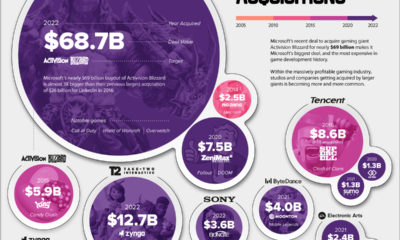Since this tipping point, pro sports has thrived around the world, and the business of sports has evolved into a multi-billion dollar ecosystem for teams, leagues, players, merchandisers, sponsors, broadcasters, and event spaces. Today, this evolution still continues – and it is being driven by the emergence of eSports (electronic sports), an exciting frontier for fans and business alike.
eSports Extravaganza
Today’s chart breaks down the eSports boom, including data on the sector’s rapid growth, prize pools, and the most valuable eSports companies today.
Despite having a reputation in the media and in popular culture as being on the fringes, it is clear that gaming is now a truly mainstream phenomenon. In fact, the global gaming industry has now eclipsed $135 billion in revenue worldwide – a figure that is twice as much as the film and music industries combined. With hundreds of millions of avid fans around the world, demand to watch the most elite gamers has reached a fever pitch – and now, it’s not uncommon to see sold-out arenas, big name sponsorship deals, and massive prize pools in the name of eSports.
Defining the eSports Ecosystem
Like any professional league, eSports creates the foundation for an entire ecosystem of opportunities. Players Players are central to the ecosystem, since they are the stars and they have their own personalities. One famous star is Kuro Takhasomi (KuroKy), who has brought in a whopping $4.2 million in prize money from Dota 2 tournaments so far. He has earned more than any other player in eSports. Teams Because the games played are mostly team-based, there is a crucial element of teamwork involved. eSports franchises are currently selling for millions of dollars. It’s worth noting that these franchises don’t just employ players – they also hire staff that can better ensure the success of players, such as coaches, trainers, and personal chefs. Games and Developers Some of the most important games in the eSports world right now include: Dota 2, Counter-Strike, League of Legends, Overwatch, Fortnite, and Call of Duty. Competitions Leagues and tournaments can offer massive prize pools for players. The biggest single pool so far was $25.5 million, offered for a Dota 2 tournament in 2017 (“The International”). It’s the second-largest prize pool offered in any kind of sport, behind the U.S. Open (tennis). Organizers Running eSports events is big money, and organizers of events can tap into sponsorship and fan revenue. Sometimes game publishers will organize the events, but third-party ones also exist in the ecosystem. Sponsors Sponsors like Coca-Cola, Intel, and Mercedes-Benz have shelled out millions of dollars to sponsor events and reach the massive audiences associated with eSports. In more recent news, SAP signed a deal to sponsor one of the biggest names, Team Liquid. Broadcasters Broadcasters, both traditional and online (YouTube, Facebook Live, Twitch, etc.), are also in to get a part of the action. Recently, game developer Blizzard signed a broadcasting deal with Disney to broadcast Overwatch League playoffs on ESPN, ABC, and Disney XD. What do you think is the most exciting part of the eSports boom, and why? on But fast forward to the end of last week, and SVB was shuttered by regulators after a panic-induced bank run. So, how exactly did this happen? We dig in below.
Road to a Bank Run
SVB and its customers generally thrived during the low interest rate era, but as rates rose, SVB found itself more exposed to risk than a typical bank. Even so, at the end of 2022, the bank’s balance sheet showed no cause for alarm.
As well, the bank was viewed positively in a number of places. Most Wall Street analyst ratings were overwhelmingly positive on the bank’s stock, and Forbes had just added the bank to its Financial All-Stars list. Outward signs of trouble emerged on Wednesday, March 8th, when SVB surprised investors with news that the bank needed to raise more than $2 billion to shore up its balance sheet. The reaction from prominent venture capitalists was not positive, with Coatue Management, Union Square Ventures, and Peter Thiel’s Founders Fund moving to limit exposure to the 40-year-old bank. The influence of these firms is believed to have added fuel to the fire, and a bank run ensued. Also influencing decision making was the fact that SVB had the highest percentage of uninsured domestic deposits of all big banks. These totaled nearly $152 billion, or about 97% of all deposits. By the end of the day, customers had tried to withdraw $42 billion in deposits.
What Triggered the SVB Collapse?
While the collapse of SVB took place over the course of 44 hours, its roots trace back to the early pandemic years. In 2021, U.S. venture capital-backed companies raised a record $330 billion—double the amount seen in 2020. At the time, interest rates were at rock-bottom levels to help buoy the economy. Matt Levine sums up the situation well: “When interest rates are low everywhere, a dollar in 20 years is about as good as a dollar today, so a startup whose business model is “we will lose money for a decade building artificial intelligence, and then rake in lots of money in the far future” sounds pretty good. When interest rates are higher, a dollar today is better than a dollar tomorrow, so investors want cash flows. When interest rates were low for a long time, and suddenly become high, all the money that was rushing to your customers is suddenly cut off.” Source: Pitchbook Why is this important? During this time, SVB received billions of dollars from these venture-backed clients. In one year alone, their deposits increased 100%. They took these funds and invested them in longer-term bonds. As a result, this created a dangerous trap as the company expected rates would remain low. During this time, SVB invested in bonds at the top of the market. As interest rates rose higher and bond prices declined, SVB started taking major losses on their long-term bond holdings.
Losses Fueling a Liquidity Crunch
When SVB reported its fourth quarter results in early 2023, Moody’s Investor Service, a credit rating agency took notice. In early March, it said that SVB was at high risk for a downgrade due to its significant unrealized losses. In response, SVB looked to sell $2 billion of its investments at a loss to help boost liquidity for its struggling balance sheet. Soon, more hedge funds and venture investors realized SVB could be on thin ice. Depositors withdrew funds in droves, spurring a liquidity squeeze and prompting California regulators and the FDIC to step in and shut down the bank.
What Happens Now?
While much of SVB’s activity was focused on the tech sector, the bank’s shocking collapse has rattled a financial sector that is already on edge.
The four biggest U.S. banks lost a combined $52 billion the day before the SVB collapse. On Friday, other banking stocks saw double-digit drops, including Signature Bank (-23%), First Republic (-15%), and Silvergate Capital (-11%).
Source: Morningstar Direct. *Represents March 9 data, trading halted on March 10.
When the dust settles, it’s hard to predict the ripple effects that will emerge from this dramatic event. For investors, the Secretary of the Treasury Janet Yellen announced confidence in the banking system remaining resilient, noting that regulators have the proper tools in response to the issue.
But others have seen trouble brewing as far back as 2020 (or earlier) when commercial banking assets were skyrocketing and banks were buying bonds when rates were low.














